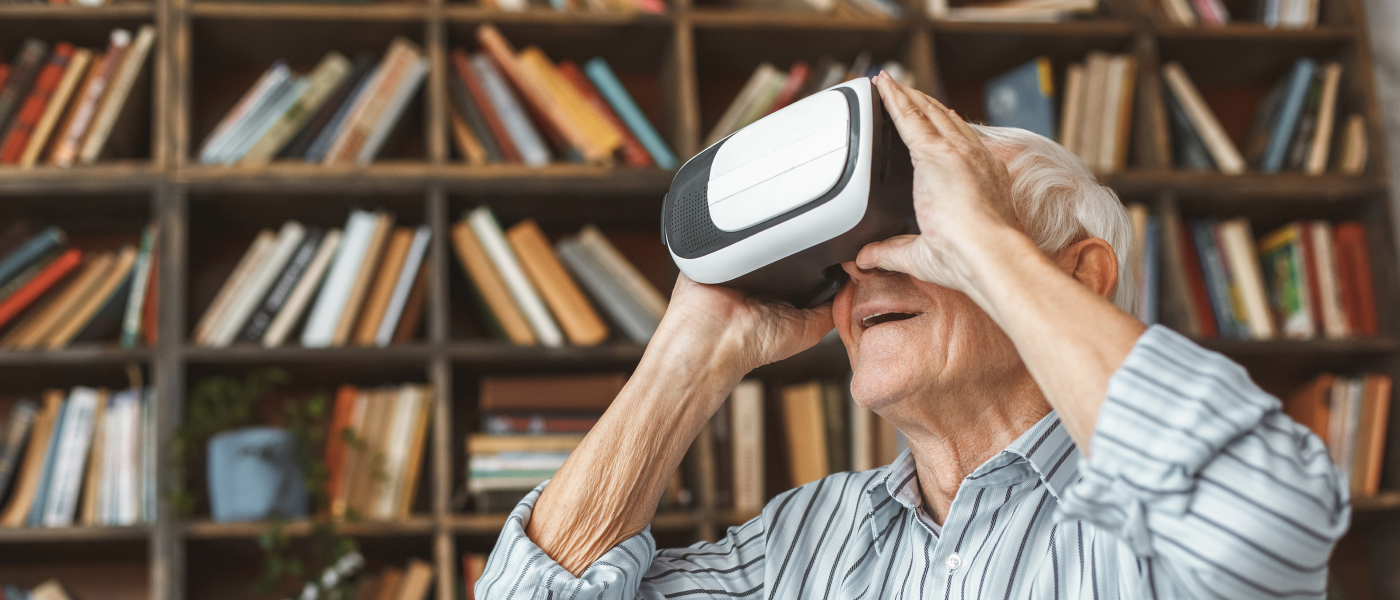When we think about video games and cutting-edge technology, older adults aren’t always the first group of individuals to come to mind. However, virtual reality (VR) is changing the way older adults interact with technology and the world around them. According to Investopedia, VR refers to a computer-generated simulation in which a person can interact within an artificial three-dimensional environment using electronic devices. Virtual reality isn’t just for gamers. The same VR technology that’s used to overcome otherworldly creatures is being used in the senior living industry. Some of the benefits of virtual reality for seniors include helping to reduce loneliness, improving medical care, and providing adventure and entertainment.
Virtual Reality Benefits
As retirement communities continue to introduce the immersive experience of virtual reality to their residents, many find that the benefits extend farther than just a form of entertainment. Researchers agree that virtual reality has physical, mental, and social benefits for older adults. Here are some of the most common benefits of virtual reality:
Keeps the brain active
As we age, it’s normal to experience some age-related forgetfulness. However, many older adults experience abnormal brain changes that can result in significant memory loss. Researchers have suggested that VR can help improve cognitive health in older adults. A recent study from the University of Maryland reported an 8.8% improvement in accuracy when using VR to learn and retain new information. Other studies have suggested that VR can help strengthen neural connectors that help support our sensory, motor, and cognitive skills, allowing us to improve cognition.
Promotes movement
Virtual reality is intrinsically interactive. As users explore new places and activities through VR, movement is a natural reaction. Many older adults, especially those not ambulatory, experience improved physical health due to upper torso, neck, and core engagement, arm movement, and a reduced perception of physical pain.
Promotes social engagement
Virtual reality can be used individually or in a group setting. Because of VR, older adults can take virtual field trips to visit new places or experience new activities together. VR makes socializing easier and more natural by providing a shared experience, which is critical when building and maintaining new relationships. Socialization helps to create a sense of purpose, promotes feelings of belonging, improves self-esteem, and strengthens physical and mental health.
Provides educational opportunities
Virtual reality is used to change the way we learn new things. As we age, it can become harder to learn and retain new information. However, VR provides a new way to connect with the world around us and learn new things. VR allows us to disconnect from traditional learning environments and establish new forms of learning through real-life experiences and gaming technologies.
Evokes the familiar
For those who experience Alzheimer’s disease or other forms of dementia, VR can provide a sense of comfort by evoking memories from the past and feelings of nostalgia. A VR headset can be programmed to show images from one’s past, such as images from the neighborhood you grew up in, a school you attended, or a childhood home.
Eases physical pain
In addition to providing entertainment to older adults, VR technology can be used to improve medical care. Virtual reality can ease physical pain and help manage chronic diseases by providing a distraction during medical procedures that are uncomfortable or induce anxiety.
Strengthens relationships
Virtual reality can provide a fun and interactive activity for families to participate in when visiting their loved ones. VR can be particularly engaging for grandchildren and helps promote intergenerational connections.
Prevents social isolation
According to the Centers for Disease Control and Prevention, nearly one-fourth of adults 65 and older have reported feeling socially isolated. Older adults are at an increased risk of isolation and loneliness because they are more likely to experience risk factors such as living alone, losing a family member, or developing a chronic illness. When untreated, long-term isolation can cause depression, anxiety, heart disease, and high blood pressure. However, VR technology can help combat this by allowing seniors and their families to explore together, helping bridge the physical distance between them.
Virtual Reality at Inspīr
As part of our Allī Technology Suite, residents have the opportunity to engage in virtual reality experiences. Featuring 360-degree visual immersion, our award-winning virtual reality experiences provide residents with opportunities for virtual travel and reminiscence therapy, transporting them to new and familiar places all over the world.





